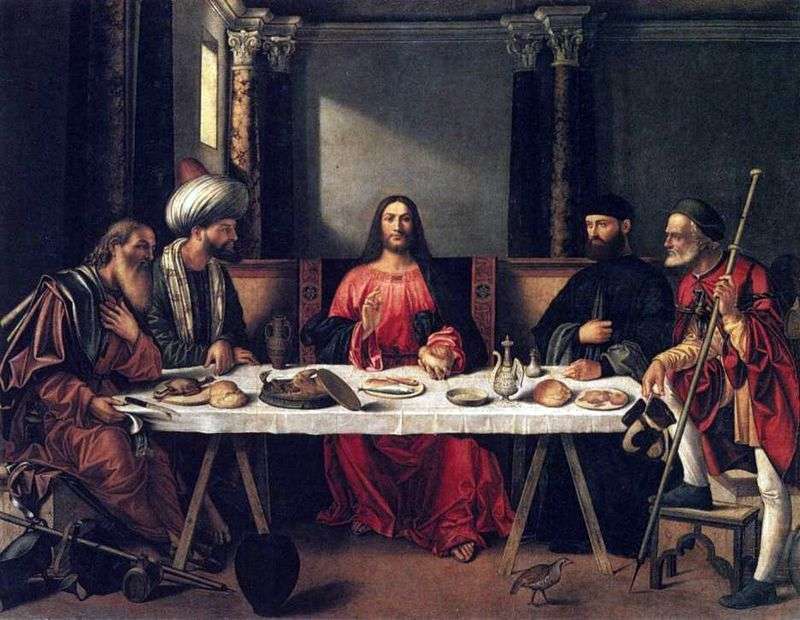
“Dinner at Emmaus” is a popular story in Christian art. It is based on the episode described in the Gospel of Luke.
After the crucifixion of Christ, two of his apostles invited a stranger, whom they had just met, to share a dinner with them. During the meal the stranger blessed everyone and broke bread. At that moment the apostles realized that their guest, in fact, was a resurrected Jesus. It is the brief moment of this insight that Caravaggio portrays.
For whom the artist painted a painting – it is unknown, one can only say that it was created in Rome, in 1602, at the height of the reformation.
This period was characterized by the need of the church to convey its ideas and messages directly to believers, including through carefully selected works on religious topics. To follow this directive, the master of that time should have been as realistic as possible. Thus, the style of Caravaggio was as if specifically designed to create works of art on biblical themes, which corresponded to the tasks posed by the clerical power.
Transmission of a deep drama of the picture is the use of chiaroscuro. As in many other works of Caravaggio, one can observe here the predominance of dark brown tones; in a closed room, a bright light is used, descending vertically onto the people depicted, thus creating a strong contrast with the darkened areas.
Unlike many paintings of the time, which were based on a linear perspective, Caravaggio tries to erase the boundaries between the picture and the viewer, the space of the picture – and the real space. There is a feeling that the author does not want his characters to exist only within the canvas. Figures on the canvas are directed forward, towards the viewer, and the wall behind them seems to be pushed a few meters away.
It seems that the outstretched hand of the apostle on the right from the inside touches the canvas on which the painting is painted. The elbow of the second looks as if he really crossed the line between the space of the picture and reality. A basket of fruit, unreliable standing on the edge of the table, creates the feeling that it can be overturned by the slightest push. The inclusion of the depicted in real space is facilitated by the lack of sex in the picture.
For such optical illusions in the works of Caravaggio, a new religious atmosphere in Rome was ideally suited. So, St. Ignatius Loyola in his spiritual exercises called upon believers to use all five senses when considering Christian works, not only to understand the story on the canvas, but also to try to physically imagine themselves in the depicted scene.
Like “St. Matthew,” the painting “Dinner at Emmaus” was also criticized. Many were confused by the village view of the apostles and Christ, who – contrary to the canons – was depicted beardless.
“Lack of decency” is the most common criticism of Caravaggio. The rejection of contemporaries evoked the desire of Caravaggio to show the apostles in an unadorned form – dirty, ragged, untidy.
Remarks were also caused by the fruits on the table: grapes, figs and pomegranate. This is the autumn fruit, while the crucifixion and resurrection of Christ occurred in the spring. But the choice of these fruits can be explained if we take into account their symbolic significance. A rotten apple is a symbol of temptation and the fall, grape symbolizes the sacrifice of Christ. Also recognizable symbol of the body of Jesus in the Christian symbolism is bread.
 Supper at Emmaus by Caravaggio
Supper at Emmaus by Caravaggio Confidence of Thomas by Michelangelo Merisi and Caravaggio
Confidence of Thomas by Michelangelo Merisi and Caravaggio Dinner at Emmaus by Giovanni Bellini
Dinner at Emmaus by Giovanni Bellini Fruit Basket by Michelangelo Merisi and Caravaggio
Fruit Basket by Michelangelo Merisi and Caravaggio Fortune-teller by Michelangelo Merisi da Caravaggio
Fortune-teller by Michelangelo Merisi da Caravaggio Madonna with a snake by Michelangelo Merisi and Caravaggio
Madonna with a snake by Michelangelo Merisi and Caravaggio The Crucifixion of St. Peter by Michelangelo Merisi and Caravaggio
The Crucifixion of St. Peter by Michelangelo Merisi and Caravaggio Madonna of Loreto by Michelangelo Merisi da Caravaggio
Madonna of Loreto by Michelangelo Merisi da Caravaggio